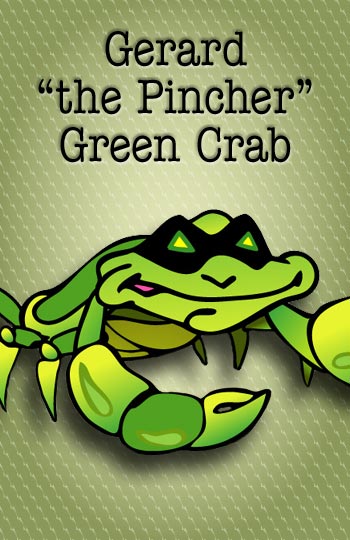Home | Detectives | Suspects | Background Check | Kids' Headquarters | Top Desk Administrator | Case Files

Carcinus maenas
Help a Marine Biologist Track Invasive Crabs!
THE CRIMES: Decimates native shellfish populations. Takes food from native fish and shorebirds. Makes some birds sick.
DESCRIPTION: Has a mottled shell, which varies in color (not usually green). During the molting cycle, the color may change from green to orange, then red. The abdomen has five spines on either side, and contains yellow patches. Two hind walking legs are relatively flat. Maximum size is from 6.35 cm (2.5 inches) to 7.6 cm (3 inches).
The Interrogation
Where are you from?
I came from the coasts of the
North and Baltic Seas in Europe. Now I’m a bi-coastal resident
in the Atlantic and Pacific Oceans. I have been in the Atlantic for
almost 100 years, but it wasn't until the 1990s that I reared my ugly
head in the Pacific. It’s been easy to adapt
to these new environments because I like all sorts of coastal
habitats, enjoy a huge temperature range, and can make my way easily
in different salinity (salt) levels.
How did you get here?
I’ve found so many ways to invade new places.
First, when I’m in the larval stage I ride the
ocean currents. As a young punk, I take advantage
of the tides and currents to move into the upper
intertidal zone where I multiply like crazy. Did
you know our females can produce up to 200,000 eggs
at a time? Some people think it was the strong el Niņo
currents of 1998 that washed me from the San Francisco
Bay in California up to Oregon and Washington.
You humans can be great at aiding
and abetting our crimes by moving us around where
we don’t belong! When you ship live seafood,
like oysters and lobsters, I hide out in the seaweed
packing. Sometimes fish farmers accidentally put me into waters
where I’ve never been before. Boaters can move
me and my gang in bait buckets or boat wells,
without realizing what trouble you’re causing. Sometimes
people buy me, either as a pet or to use in research.
And, when they’re done with me, guess what? They
dump me into lakes, streams or ponds and my aquatic
neighborhood gets even bigger. Of course, like many
other pesky invaders, I’m a stowaway in the ballast
water of marine vessels.
What’s your problem?
If you like Dungeness crab, clams and
oysters, BEWARE because I’m a glutton for these tasty morsels.
I am such a good predator because I show no mercy. I’m really
quick, I can open bivalve shells easily with my claws, and I can’t
seem to get enough—sometimes I eat 40 half-inch clams in one day.
I also take food that your native fish, crabs and birds would normally
enjoy. Sometimes I do a real number on birds because I serve as a host
to a marine worm that makes birds sick when they eat me.
Not only do I annoy you people in North America,
but I’m also a nuisance to people trying to enjoy the waters
of South Africa and Australia.
How can we control you?
You have a hard time conquering my
many gangs because you can’t use really big
weapons, like lots of pesticides, in a coastal area.
You’d end up killing a lot of innocent bystanders
that belong in those waters. One way to hit me hard is to
use the dreaded parasitic barnacle to keep me from
reproducing. The larva get inside me and affect
my sex organs (of all the sneaky, underhanded tactics).
But scientists don’t know whether this control
method is safe. Divers can help by learning how
to identify me and reporting any new sightings.
People need to clean their boats and bail buckets so
they don't spread me around.
Reward:
The honor of protecting our water resources— A healthier environment
and more opportunities to enjoy our natural areas.